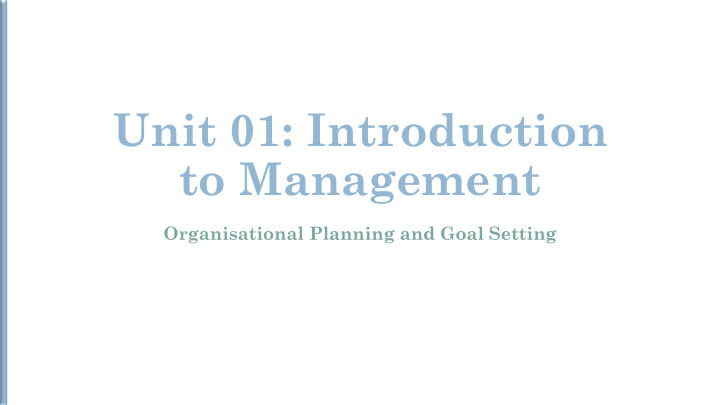



Unit 01: Introduction to Management Organisational Planning and Goal Setting
Introduction to organisational planning • Determining organisational goals and defining the means for achieving it. • A plan: an outline for goal achievement and specifies’ • Resource allocation • Schedules • Tasks Goal: A desired future state that the organisation attempts to realise
Strategic Planning Process • Encourages management to think beyond the day to day activities. Answers questions of: Where are we now? Where do we want to go? How are we going to go?
Strategic Planning Process
Vision Statement • Is an aspirational view of the desired state of an organisation at the point in the future. • The ideal state organisation wishes to achieve • Vision is inspirational and aspirational and should challenge employees Transforming lives and influencing the future through transmission of knowledge.
Mission Statement • Mission is considered useful in shorter run as it defines the road map for the accomplishment of vision. • Mission statements may contain the indications on the following: • Industry or business the organisation is mainly concerned with • Indication of the realistic market share or market position the organisation should aim towards • Summary of the values and beliefs of the organisation • Specific and highly context dependent objectives BMS is committed to creating an intellectually stimulating learning environment through inspirational teaching and research within an inclusive academic culture that benefits the learner, community, country, and the region.
Goals: Levels of Goals Mission Statement Broad statements describing where the organisations want to Strategic Goals be in future. Relates to the overall organisation as a whole. Results that major divisions and departments within the Tactical Goals organisation intend to achieve Results expected from department, work groups and Operational Goals individuals.
Objectives • Quantitative objectives : Related with financial targets • Qualitative objectives : Related with market based aspirations such as market share, customer service, repeat business, customer retention, employee retention. Explicit objectives: Objectives those are obvious and stated publicly by the organisation Implicit objectives: These are subobjectives to support explicit objectives
SWOT Analysis • Analyses the key issues and opportunities from the business environment and the strategic capabilities of an organisation those are most likely to impact the strategy development. • Starts by reviewing the strengths and weaknesses: INTERNAL CHARACTERISTICS • Evaluates the external opportunities and threats: EXTERNAL ENVIRONMENT
SWOT Analysis Strengths and Weaknesses: Opportunities and Threats: • Management and organisation • Political environment structure • Economic factors • Social factors • Marketing • Technological factors • Human resources • Environmental factors • Financial performance • Legal factors • Production • Supplier factors • Research and development • Customer factors • Competition • Potential threat from new entrants
Porter’s Five Forces Analysis Barriers to Entry Threat of New Evaluates the : Entrants/ This analyses the competitive Current competition forces that will determine the Potential competition in near degree of competition and ability to future generate profits within an industry. Intensity of current Bargaining Power of Bargaining Power rivalry in the industry Customers of Suppliers Substitutes Threat of The attractiveness of the market Industry is a group of firms producing the same principle product.
Porter’s Five Forces Analysis Force Description Threat of new Extent to which there are barriers to entry entrants Higher degree of barriers to entry: threat of new entrants will be low Low degree of barriers to entry: threat of new entrants will be high Threat of substitutes Depends on the nature of the product being traded in the market Bargaining power of The power the organisation has towards its customer which will reflect the amount customers of pricing power it has towards the customers Bargaining power of The extent to which supplier has pricing power over the organisation suppliers Competitive rivalry The extent to which competition exists in the industry
Ansoff’s Matrix: Strategies for Growth Increase risk NEW PRODUCTS EXISTING PRODUCTS EXISTING MARKETS Product Market Penetration Development Increase risk NEW MARKETS Market Diversification Development
Thank You!
Recommend
More recommend